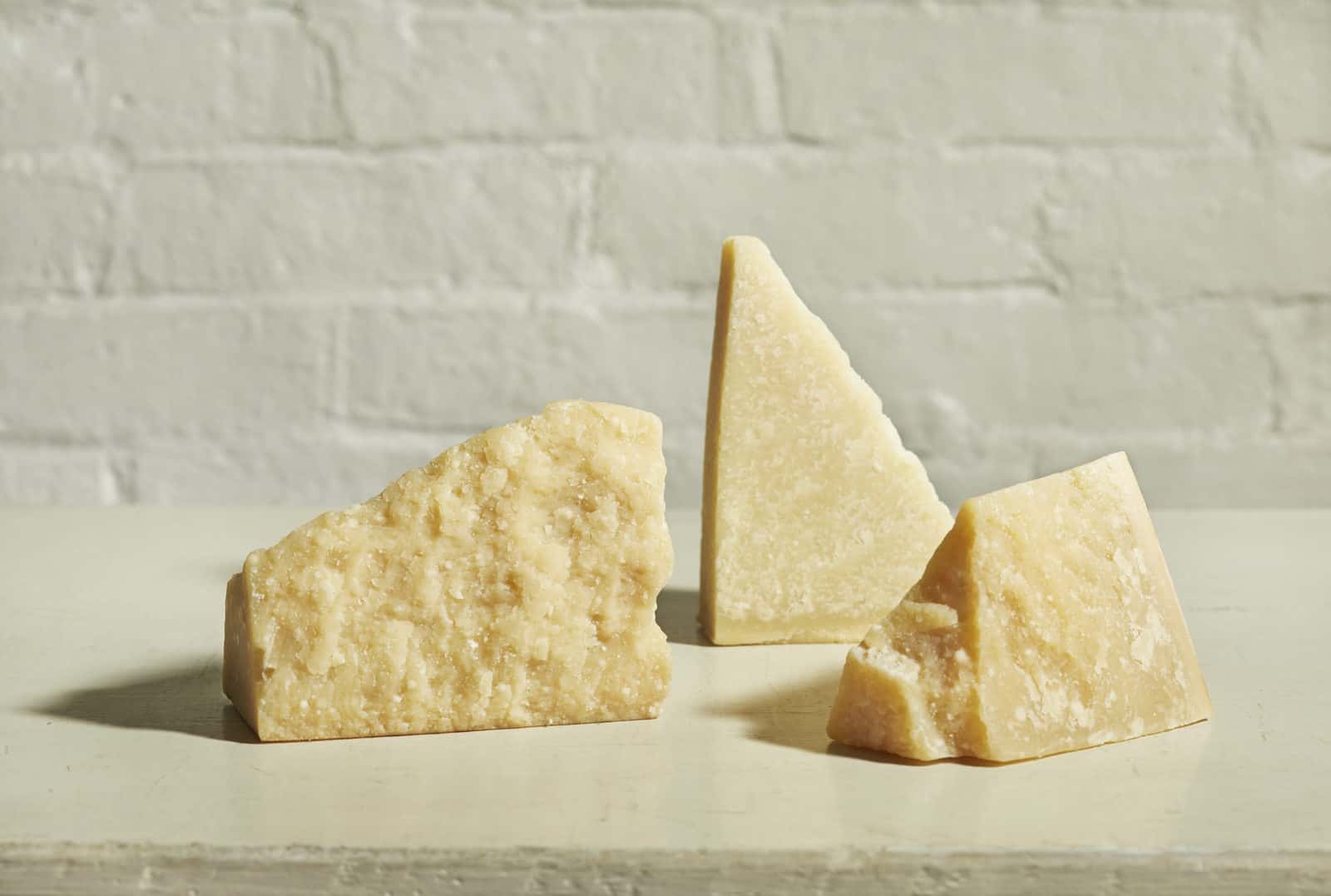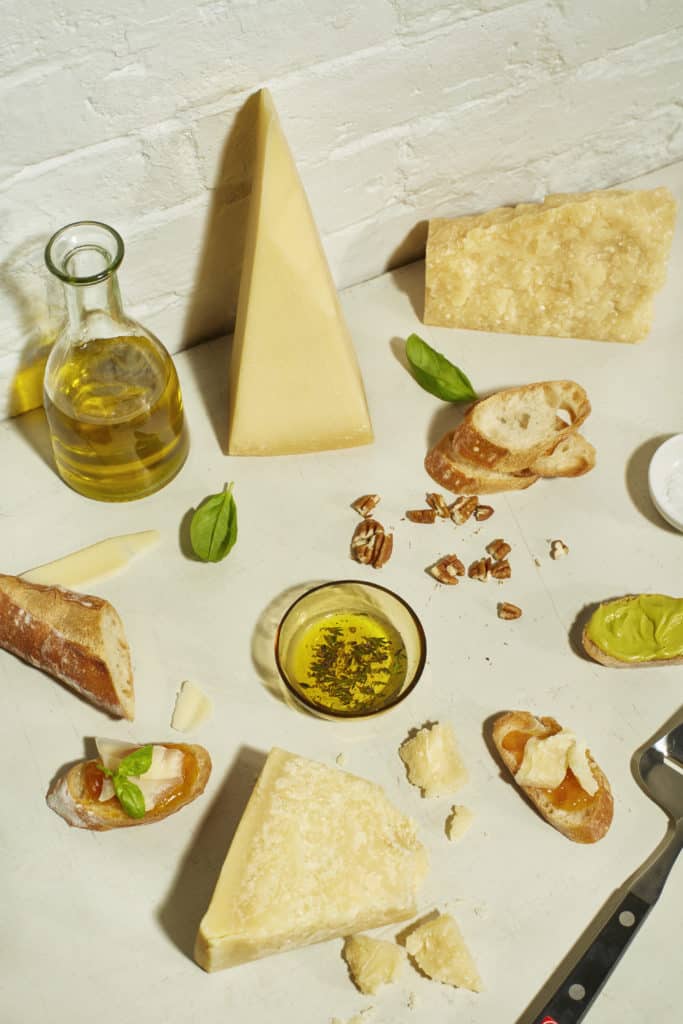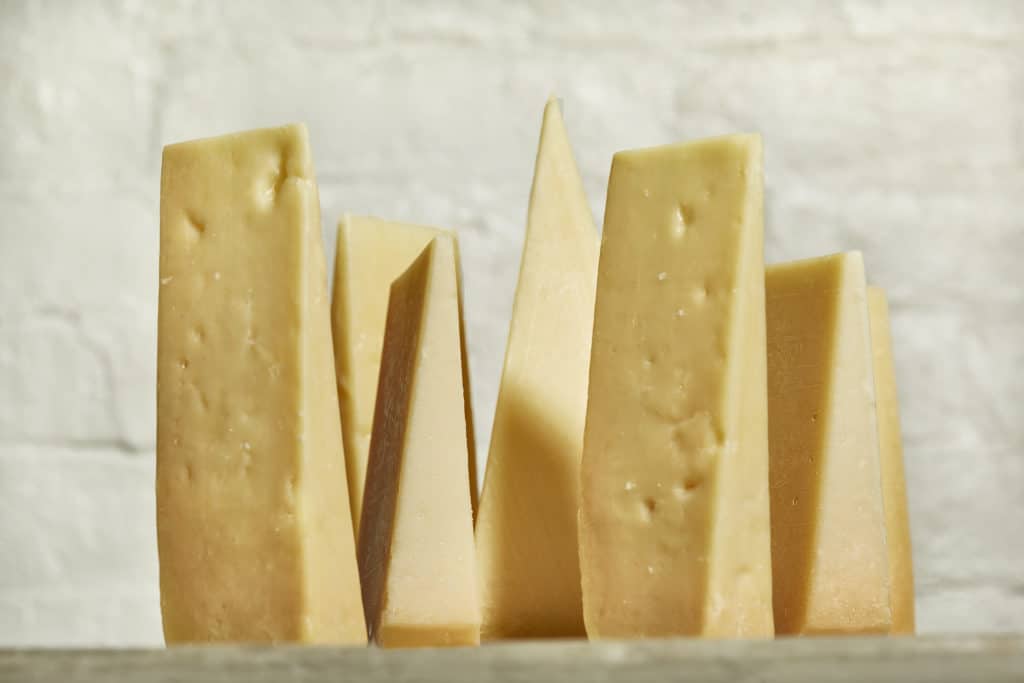
Photographed by Nina Gallant; Styled by Chantal Lambeth
From the mountains of Modena to the midwestern plains, grana is made all over the world. Though the style originated in Italy with 12th-century Cistercian monks, it has since sprung up anywhere Italians have made their home—like Argentina and New Jersey, to name a few places.
Though Grana Padano may be the most well-known use of the word, “grana” simply means grain and refers to an entire family of mature cheeses that includes Parmigiano Reggiano and regional riffs like Trentingrana, Gransardo, and Granone Lodigiano. Most are named some variation of grana + province—Giorgio Cravero, a Parmigiano Reggiano affineur in Italy, can recall a time when his family invoiced their cheese as simply “Grana Reggiano.”
The style’s namesake texture derives from the use of partially skimmed milk. Low-fat curds are agitated until rice-like, then cooked at high temps to shed even more moisture, creating a hard paste much easier to grate than aged cheeses like cheddar or Comté.
The style’s scope may seem narrow, but that simplicity leaves room for infinite variation. At Eataly’s Flatiron location in Manhattan, you can buy single-breed Parmigiani made with the milk of only brown, red, or white cows. Michigan-based cheese shop and online retailer Zingerman’s offers an organic Parmigiano, and one made by a female cheesemaker. Murray’s shop in Greenwich Village sells a five-year-old variety. The one Cravero ages comes from cows who graze only in the mountains, as does Trentingrana, which hails from the high pastures of Trentino-Alto Adige.
A few of these improvisations carry their own Protected Designation of Origin (PDO), stipulating rules that set them apart from their peers. Most, however, start the same: with the fresh evening milk of cows who live in the designated production area, mixed with full-fat morning milk in copper cauldrons. Calf rennet coagulates the milk, while whey from yesterday’s cheese cultures it.
Parmigiano Reggiano, the strictest of the PDOs, must be made in Parma, Modena, Reggio Emilia, or specific parts of Mantua or Bologna. A majority of the cow’s food must be grown in the cheese’s production area, and wheels must be aged a minimum of 12 months. For Nicola Bertinelli, president of the Parmigiano Reggiano Consortium and a PDO Parmigiano maker himself, all these rules are about guarding tradition. “This cheese is essentially produced like [it was] nine centuries ago, using the same ingredients, with the same craftsmanship and production technique,” he says.
Grana Padano is a bit more easygoing, expanding the production area to the entire Po River valley and accepting anything nine months or older. Grana Padano also allows the use of two ingredients forbidden in Parmigiano: silage and lysozyme.
Silage—or feed that’s been fermented in a silo—is a point of contention in many protected cheese styles. Cows love the stuff—but so do harmful bacteria, which is why the milk of cows fed silage is often treated with lysozyme, a protein (present in human tears and breast milk) that inhibits bacteria. Additives are not allowed in Parmigiano, so lysozyme (and, as a result, silage) is forbidden.
Though it’s unclear why, most stateside attempts at grana hail from Wisconsin. Cheesemakers Sartori, BelGioioso, Schuman, and Eau Galle all craft grana-style wheels in the Badger State, using methods not too far off from the Italians.
“When we make Parmesan at Sartori Cheese, we build on our Italian heritage,” said Sartori cheesemaker Pam Hodgson.“The Sartori family immigrated from Italy in 1907 and like other immigrants, they brought their food traditions with them.”All of the milk for Sartori’s cheeses, which include Parmesan and SarVecchio extra-aged Parmesan, comes from within 75 miles of the plant, from a mix of mostly Holstein and Guernsey cattle—two breeds milked in the Po River valley.
For American Grana®, BelGioioso uses the fresh milk of Holstein cattle like they do in Italy, in addition to making their own cultures and taking other measures to get as close to the real deal as possible.“We do send our cheesemakers to Italy to learn, and also have production technicians come over to the U.S. from Italy to guide and troubleshoot our techniques,” president and founder Errico Auricchio says. “We have certified Master Cheesemakers producing this cheese… It’s a quality cheese, with great nuances in flavor.”
Aside from this handful of producers, though, American artisan cheesemakers largely steer clear of grana, which many attribute to the requisite long aging.
“The timeline to develop an excellent grana is years, not the weeks or months for softer, younger styles,” said Rachel Fritz Schaal, co-owner of Vermont’s Parish Hill Creamery. She and her husband, Peter Dixon, make several Italian-style cheeses, but no granas. “Someone wanting to make a cow milk grana would need…appropriate aging space, and be willing to sacrifice that real estate for several years,” she said.
Usually a few months younger than their Italian counterparts, the American granas tend to be sweeter and milkier, with less of the craggy texture, golden hue, and spicy tingle of those from the Bel Paese. But for Cravero, it’s about more than a difference in age.
“If you plant the Nebbiolo grape in Napa Valley, probably you are going to produce a very good wine—but it’s not Barolo,” he said. “Because there’s a special soil…the soil in Wisconsin, it’s very good to produce a grana style, but it’s not ours.”
—TASTING NOTES—
Parmigiano-Reggiano 5 Years
Lanfredini Farm
Parma
The oldest cheese on this list surely has no business tasting like a Starburst, yet this five-year-old parm packs youthful flavors into its crystalline paste. Dense yet crumbly, the Lanfredini’s cheese leaves you with juicy notes of fig and raisin, and a surprisingly spicy throat buzz.
Grana Padano PDO
Agriform
Verona
Grana Padano is milder than parm, and this gentle offering is no exception. Made from the milk of a co-op of dairies in Padua, Mantua, Vicenza, and Piacenza and aged 16 months, this pale white grana has notes of hay and cooked leeks, and a very fine melt-in-your-mouth grain.
Trentingrana DOP
Gruppo Trentino
Trentino-Alto Adige
This Slow Food-protected grana is made near the Swiss border, and those cooked-curd mountain flavors are on full display here. The herbaceous and floral Trentingrana is made only in summer, when cattle are grazing the Sol and Primiero valleys. After aging 18 months, it has a brown butter candy crunch and rich golden paste that’ll steal the show on any cheese plate.
American Grana
BelGioioso Cheese
Wisconsin
American Grana curds undergo additional agitation to achieve a smaller grain, and the result is a densely compacted marble-like paste. BelGioioso ages its traditional 70 pound wheels on wooden boards for 18 to 24 months, and the result is sweet, intensely nutty, and will give any Italian grana a run for its money.
Copper Kettle Parmesan
Cello Cheese
New Jersey / Wisconsin
Made in copper kettles using a traditional Grana Padano recipe and aged 20 months, this stateside take hews close to the Italians. Notes of sea salt brine and nutty caramel infuse this dry, granular cheese, while a lingering tingle of heat tickles your nose.
SarVecchio Parmesan
Sartori Cheese
Wisconsin
Milky and mild despite its 20 months of age, the pinkish-gold rind and cream-white interior of this parmesan contain hints of yogurt, cashew, and vanilla, with sparse crystallization and a velvety thickness that coats your tongue like nut butter.
—WHAT TO DO WITH ALL THOSE RINDS—
As granas age, briny cave umami adheres to their rinds, building up a stockpile of flavor we can’t bear to throw away. Here are a few ways to put this abundant grana flotsam to work in your kitchen:
- Snacking: Hear us out—if your rind doesn’t have a waxy coating (and if it does, just use a Microplane to grate it off), you can literally eat it as is. Just throw it under your broiler until chewy, and serve with some crusty bread.
- Risotto: For extra cheesy flavor, stir rinds into your simmering rice. Once the rind has softened, chop it up and stir it into the finished product for texture.
- Parmesan broth: Save up a stash of rinds in the freezer, then boil them in water with your favorite aromatics for a broth that can take the place of veggie or chicken stock.
- Tomato sauce: Want to make jarred tomato sauce taste like it simmered for hours? Heat it up in a pot with a grana rind or two.
- Boiling liquid: Almost anything boiled can benefit from a rind in the pot. Softening potatoes to mash? Cooking pasta? Blanching some greens? Throw a rind in there.
- Infused oil: Place your leftover rinds in a sealable jar with a few garlic cloves and olive oil. After a few days, you’ll have a funky pot of liquid gold to dunk bread into, and a great pasta or salad dressing.
- Serving vessel: If your rind forms a right angle: Hollow it, cube the cheese, then serve the cubes tumbling dramatically out of their rind. If you’re lucky enough to have a half wheel: Build a dish like fettuccine alfredo in the bowl, using the heat of the noodles to coax any remaining cheese off the walls. Serve with bread for scraping up every last drop.






